|
SID '05 Expands
Organizers add new events and more technical sessions to serve a new era of display technology and products, providing more value for attendees.
by Ken Werner
THE Society for Information Display's International Symposium, Seminar, and Exhibition, to be held May 22–27, 2005, is the premier international forum of the display industry. It incorporates the largest exhibition in North America exclusively devoted to electronic displays; display components; display-manufacturing equipment; display test and measurement equipment; display controllers, electronics, and semiconductors; backlights; display products and materials; software; services; and publications (Fig. 1). Exhibit Manager Danielle Rocco said that over 500 exhibit booths have been sold thus far – at least 30 more than last year's total of 470.
This year, "Display Week" will be more varied than ever before. The technical program, which previously filled three days, will now also occupy a fourth day – Friday, May 27 – and will contain over 450 papers. The successful Business Conference, which drew 700 attendees last year, has been expanded from one to two days, and a new Investors Conference will be held on Wednesday, May 25.
Conference Chair Dick McCartney (National Semiconductor Corp.) explained, "Despite the fact that much of the display industry is based outside the U.S., the SID Technical Symposium is the single best venue in the world to present, and stay abreast of, new display advancements.
"As a result, in the past decade, the number of papers submitted to the Technical Symposium has doubled, yet our three-day format of Tuesday, Wednesday, and Thursday remained fixed," McCartney said. "We are accommodating the growth this year by adding Friday morning sessions.
"We want to be sure that the entire three-and-a-half days of the Technical Symposium are of substantial value to attendees, so we are scheduling many of the most significant papers on Friday, after the exhibition has closed. As a result, these high-interest papers will not compete with the exhibition, and the exhibitors' technical personnel will be free to listen to the papers."
Another change is that the winners of the Display of the Year Awards – the industry's premier awards for display panels, display systems, and display materials and components – will now be announced and presented at SID '05. "The Display of the Year Awards have become celebrated achievements in our industry.
The standards for these awards are very high, and I am delighted with the opportunity to reveal this year's winners as part of the keynote ceremony at SID '05. This is a great addition to our program," McCartney said.
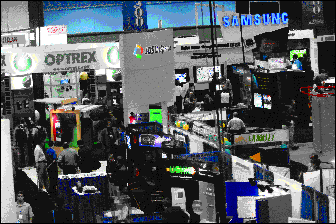 Carl Murray for SID Carl Murray for SID
Fig. 1: Display Week features the largest exhibition in North America devoted to electronic displays, components, and equipment.
Display Week is covered by approximately 100 technical and business journalists from around the world.
Keynote Session
The formal opening of SID 2005, together with the Keynote Addresses and the presentation of the Display of the Year Awards, will be on Tuesday morning.
The first keynote will be delivered by Sang Wan Lee, President and CEO of Samsung Electronics, LCD Business [Fig. 2(a)], who will look at the coming generations of AMLCDs, and how they will be used in television, desktop monitors, and laptop PCs.
Then, Harold Hoskens, Senior Vice President and General Manager, Philips Mobile Display Systems [Fig. 2(b)], will discuss mobile displays for personal electronic products of the near – and not-so-near – future.
In the third keynote, Jean-Louis Bories, Senior Vice President and General Manager of National Semiconductor's Displays and Wireless Group [Fig. 2(c)], will analyze the increasing – and increasingly critical – role of electronics in display devices.
To obtain the full program of Display Week's many events, and to register, see www.sid.org/conf/sid2005/sid2005.html.
Event Preview
Display Week will kick off with 4-hour short courses on Sunday, May 22, and the beginning of the third annual SID Business Conference and 90-minute seminars will follow on Monday, May 23. The entire seminar program will take place on Monday; there will not be any seminars on Friday as in past years.
The Sunday Short Courses, organized by Kalluri Sarma (Honeywell), are Fundamentals of Flexible Flat-Panel-Display Technology(Gregory Crawford, Brown University), Fundamentals of Vision and Color Science for Display Technologists (Louis Silverstein, VCD Sciences, Inc.), Fundamentals of Video (Nikhil Balram, National Semiconductor Corp.), and Fundamentals of OLEDs and OLED Displays (Vladimir Bulovic, MIT).
Last year's SID Business Conference and reception drew over 700 attendees, with participants giving the presenters high grades. "The response was so enthusiastic that we are expanding this year's business content into a "Business Enterprise," consisting of a two-day business conference (May 23 and 24) and a new Investors Conference (May 25)," said Business Enterprise Chair Elliott Schlam (Elliott Schlam Associates). The Investors Conference is co-sponsored by securities and investment banking firm SG Cowen & Co. The Business Conference will share the SID Symposium's keynote session.
Since Display Week is a can't-miss event for many senior display-industry executives, the Business Conference is able to assemble an elite, international group of speakers – a group that would be hard to assemble anywhere else. This year, they include Allen Alley (CEO, Pixelworks), Peter L. Bocko (VP, Corning Display Group), Jun Souk (Executive VP, Samsung Electronics), Bruce Berkoff (Executive VP, LG.Philips LCD), Kyle Ransom (President and CEO, InFocus Corp.), Jeff Hawthorne (President and CEO, Photon Dynamics), and Thomas E. Holder (Sr. Strategic Investment Manager, Intel Capital), among many others. H. B. Chen (President and COO, AU Optronics Corp.) will deliver the opening address, 2005: Beyond the Crystal Gateway, which will discuss AMLCD business progress, especially in Taiwan.
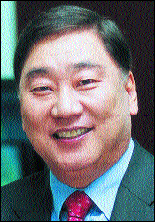 (a) (a) 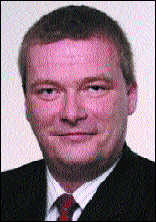 (b) (b)  (c) (c)
Fig. 2: This year's keynote speakers will be (a) Sang Wan Lee, President and CEO of Samsung Electronics, LCD Business; (b) Harold Hoskens, Senior Vice President and General Manager, Philips Mobile Display Systems, and (c) Jean-Louis Bories, Senior Vice President and General Manager, Displays and Wireless Group, National Semiconductor Corp.
|
Visiting Boston
"Boston is a rich, proud, and very clever city, fanatical about its sports teams, brimming with money and great institutes of learning." That is how Rupert Cornwell described Boston in the British newspaper The Independent as he tried to explain to his readers the impact of the Boston Red Sox victory over the New York Yankees in the American League playoffs in October 2004.
This is the city – flush with its victories in the playoffs and the subsequent World Series against the St. Louis Cardinals – that will host the Society for Information Display's annual Symposium, Seminar, and Exhibition when it returns to Boston's Hynes Convention Center from May 22 to 27.
Boston is one of America's most agreeable cities, a city remarkably rich in history, science, technology, medicine, art, music, food, and architecture. It is a compact city, seemingly made for walking. Thousands of visitors follow the painted "Freedom Trail" through the streets of Boston each year, stopping at the well-marked buildings, burying grounds, and monuments associated with America's struggle for independence.
Although famous for its passionate sports fans, Boston is just as much a city of colleges and universities. And the city's commitment to learning and education began early. Boston Latin School, the first secondary school in the American colonies, was established in 1635, just five years after Boston was founded. A year later, Harvard, the first college in the Colonies, was born. In 1638, the Massachusetts Bay Colony established the first library in the Colonies. The first printing press in the Colonies was set up in Cambridge in 1639 by Stephen Daye, and he brought out the first English-language book to be published in the Colonies the following year. In 1647, the Colony ordered that elementary schools be established in all towns with more than 50 families.
The Boston-News Letter, the first successful newspaper in the American colonies, was established in 1704. In 1852, Massachusetts became the first state in the United States to require all children to attend school.
Today, Boston and its neighboring towns are famous for their many colleges and universities, including Harvard, MIT, the University of Massachusetts, Boston College, Boston University, Brandeis University, Northeastern, Radcliffe, Tufts, Berklee College of Music, and many others. Display Week will take place in the middle of the period when proud parents and relatives are flocking to Boston for university commencement ceremonies. Restaurant reservations, especially for larger business groups, can be hard to get, so reserve early.
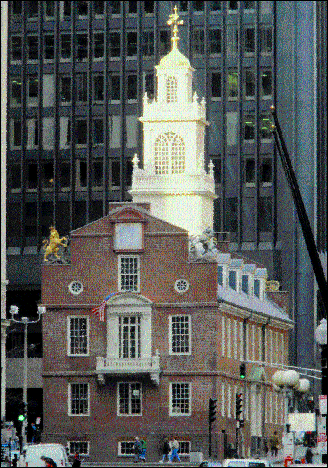 Greater Boston Convention & Visitors Bureau Greater Boston Convention & Visitors Bureau
A popular stop on Boston's "Freedom Trail" is the Old State House. On July 18, 1776, citizens of Boston gathered in the street to hear the Declaration of Independence read from its balcony.
Science and Technology
The USS Constitution, a 44-gun frigate, was built in Boston with copper fastenings made by Paul Revere and launched in 1797. The ship had a remarkable string of victories and was undefeated against the British in the War of 1812. In an engagement with HMSGuerriere on August 19, 1812, 18-pound cannonballs from the Guerriere appeared to bounce off her thick oak hull. An unidentified sailor exclaimed, "Her sides are made of iron!", giving rise to the name "Old Ironsides." Moored in Boston Harbor, she is the oldest commissioned naval vessel in the world. (The Constitution is still officially part of the U.S. Navy.) Thirty-minute tours are available throughout the day, as are ten-minute "Speed Line" tours.
In 1814, Francis Cabot Lowell built a textile factory in Waltham, near Boston, after secretly memorizing the plans for English power looms. It was the first integrated textile mill in the U.S., and was financed by a novel joint-stock ownership system. Lowell's Boston Manufacturing Company initiated many features of the modern corporation and opened the door to a new stage of U.S. industrialization. The factory is now part of the Charles River Museum of Industry, which can be reached by MBTA Commuter Rail from North Station in Boston.
In the 1870s, Alexander Graham Bell developed the telephone in Boston. A telephone line was run from Boston to Providence, Rhode Island, in 188l.
During World War II, a remarkable amount of electronic development was done in the Boston area. Particularly famous was the Radiation Laboratory at MIT, which was responsible for critical developments in radar and designed almost half of the radar sets deployed in World War II. Following World War II, Boston remained a center of electronics and computer development and manufacturing. Route 128, which makes a large loop around Boston, became known as the Electronics Highway.
Museums and the Arts
Among Boston's famous museums are the Boston Museum of Fine Arts (www.mfa.org), the Boston Museum of Science and Technology (www.mos.org), and the Isabella Stewart Gardner Museum (www.gardner-museum. com) – all highly recommended.
Some say that the Boston Symphony Orchestra (BSO) is the finest orchestra in the U.S. While the BSO's season will be over by the time of Display Week, many of the same musicians play in The Boston Pops orchestra (www.bso.org), which plays lighter fare and is perennially popular. The Pops will play every day except Mondays through the entire period of Display Week.
... and Baseball
The world champion Boston Red Sox will play at home against the Atlanta Braves, May 20–22, and against the Baltimore Orioles, May 30–31. Away games with the New York Yankees, May 27–29, will be shown on the TV sets in every sports bar in the city. There will also be away games with the Toronto Bluejays, May 24–26.
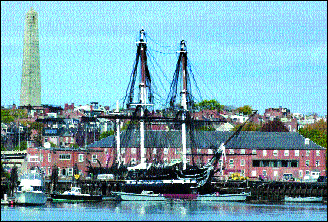 Greater Boston Convention & Visitors Bureau Greater Boston Convention & Visitors Bureau
The legendary USS Constitution, built in 1797, is moored in Boston Harbor and is open to visitors. The Bunker Hill monument is at the rear to the left.
|
|